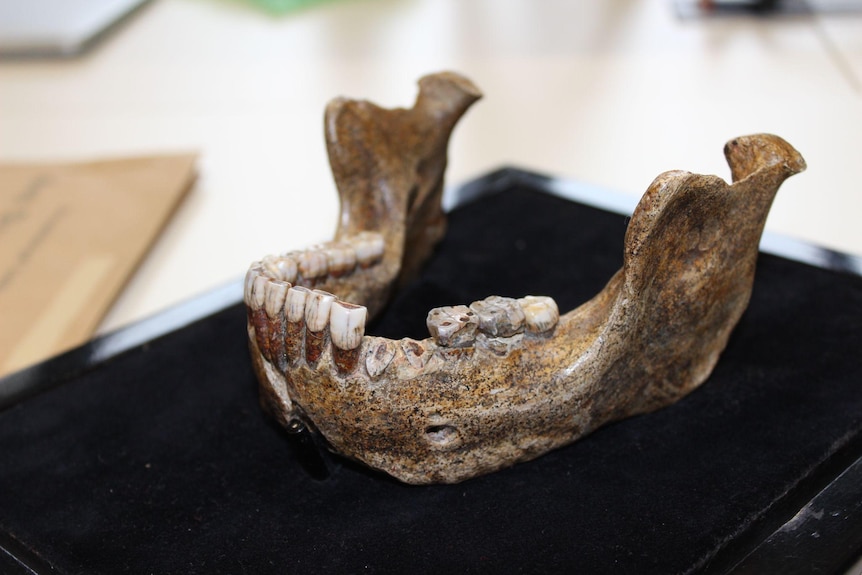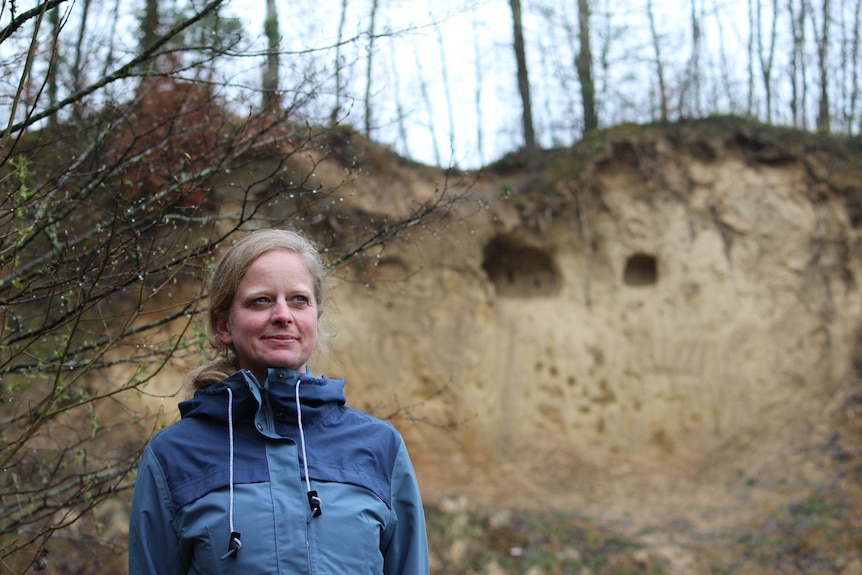The palaeontologist who fell in love with an ancient Homo heidelbergensis jawbone fossilDr Eck with the jawbone so precious it's normally stored in a locked vault.
(ABC Science: Carl Smith
"The first time I met him, I was like, 'Oh, wow, yeah!'"
It was a "meet cute" in the basement of a nondescript university building, and palaeontologist Kristina Eck was instantly head over heels.
"I fell in love, I have to admit," Dr Eck says with a wistful smile.
But the object of her affection wasn't really "human" as we know it today.
In fact, "he's" not even alive.
"He" is a roughly 610,000-year-old mandible — a lower jawbone — from one of our ancient human cousins.
A year after its discovery, the jawbone was formally classified as belonging to a new human species.(ABC Science: Carl Smith)
Their relationship is not a traditional love story, but it profoundly affected Dr Eck.
"He's a friend of mine."
Which is why she began calling "him" a "he" instead of "it" — even though Dr Eck admits this mandible could have come from a man or a woman.
Why 'he' is kept in a hidden vault
Dr Eck first met the mandible when she took over as curator of the University of Heidelberg's Institute of Geosciences Museum in 2008.
"My first love was dinosaurs," she says.
"And then I got to this institute. And yeah, this bone!"
The mandible was found in 1907 near Heidelberg, a city in the west of Germany, near the French border and just north of the Black Forest.
Sandpit Grafenrain where the mandible was found in the early 1900s. The small white cross (lower centre) indicates its location.
(Supplied: Homo heidelbergensis von Mauer e.V.)
At the time, the discovery of the mandible shook the branches of the early human evolutionary tree, and it still causes much scientific debate today.
After Homo neanderthalensis (Neanderthals) and Homo erectus, the jawbone marked only the third ancient human species discovered.
"So it's a very important thing for palaeontology," Dr Eck says.
As museum curator, she looked after the collection and its prized specimen.
And only curators are allowed to see where the mandible is stored.
She recently stepped down from the job but she's back to visit the new curator — and to check on her old friend, the jawbone.
The mandible's kept behind several security doors in the collections room, where there are rows of sealed floor-to-ceiling storage cupboards and not much natural light.
It even has its own specially constructed vault.
There's a good reason for the extra precautions.
"Unfortunately, we know from the past that there are people trying to get these," says Martina Schmalholz, who recently took over from Dr Eck as museum curator.
But Dr Eck can describe where it's kept.
"He has his own room because he's so famous and so unique," she says.
"And it's a really dark room because it should be safe from UV light."
The mandible sits in the centre of this room in an old safe with "really thick walls and there's only one key".
Dr Eck heads inside to unlock the vault and retrieve the mandible.
She reappears holding a special metal transportation case, and heads off towards a clean room.

The mandible also has its own portable metal case, secured with a code. You can glimpse part of the museum’s collections room beyond.
(ABC Science: Carl Smith)
The Heidelberg holotype
Storing an old jawbone under such tight security might seem like overkill, but the mandible is essentially priceless to scientists.
"They are really, really rare," Dr Eck says.
"I could put all [of the early] human fossils, which were found all over the world. in my car.
"[So] every human fossil is stored like [this one]."
And this mandible is even more prized than many other early human fossils.
It comes from a mysterious ancient human species called Homo heidelbergensis.
Homo heidelbergensis is believed to be a vital and recent link between the hominin species that left Africa, and both modern humans and Neanderthals.
And this mandible is the so-called "holotype" or "type specimen" — the first evidence of this species found, and the example used to describe Homo heidelbergensis.

The fossilised mandible is thicker than that of a modern human's.(ABC Science: Carl Smith)
One chunk of jawbone might not seem like enough to describe a species, but Dr Eck says a complete mandible is plenty.
"We rarely find more than one bone.
"A whole skeleton? That's a dream.
"There are ancient humans which are only based on a tooth, for example."
She gingerly lifts the mandible out of the metal case, removing sections of cushioning and plastic wrapping.
"It would be a nightmare if anything happens to this fossil."
Dr Eck uses gloves to carefully remove the mandible from its travel case.
(ABC Science: Carl Smith)
What do we know about this species?
Based on its current classification, sometime around 600,000 years ago, Homo heidelbergensis diverged from its ancestor Homo erectus.
Although much of early human history is murky and contentious, many anthropologists believe populations of Homo heidelbergensis established in Africa and Europe.
These populations appear to have spawned modern humans and Neanderthals respectively.
But there are several other theories and counter-theories, including those that argue Homo heidelbergensis shouldn't be classified as its own species at all.
In fact, in 2019, the American Association of Biological Anthropology dedicated an entire conference session to Homo heidelbergensis, concluding that "no-one was happy" with how it's currently defined.
The mandible has given scientists plenty of clues about what Homo heidelbergensis looked like — and how it might have lived.
"It's [lower jaw is] much more robust than our lower jaw," Dr Eck says.
She says it's thicker and bigger all round — and that the teeth are almost twice the size of modern human teeth.
Since the mandible's discovery, other Homo heidelbergensis remains have been found across Europe and Africa.
By analysing these and the sites they were found, researchers concluded Homo heidelbergensis were strong and tall — reaching up to 180cm in height.

The teeth are about twice the size of a modern human’s teeth.
(ABC Science: Carl Smith)
They had a large brain capacity, appear to have used tools, may have used fire, and it seems they lived in small groups.
Dr Eck points out that the owner of the jawbone, which had a fracture, may have also received some care from members of its community.
It's not known how the individual died, but she says it appears the injury healed — potentially suggesting some assistance during recovery.
"He was between 20 and 30 years old when he died. That sounds very young, but for an ancient human, that is OK."
Dr Eck says the fossil likely has many more secrets to tell, which is why she handles it carefully.
"People are still working on this. New methods make it possible to get new results."

A stained glass window at a pub in Mauer, where the mandible was found over 100 years ago.(ABC Science: Carl Smith)
The dream, Dr Eck says, is to analyse his DNA. This may help definitively find the right spot for this species on the evolutionary tree.
"But he's maybe too old at the moment for our methods," she says.
She packs the fossil back into its case, says her farewells, and puts it back into storage.
Connection to deep history
For Dr Eck, spending time with this fossil has been more than just a job.
It helped connect her to the deep history of humanity in her part of the world.
And that's also why she likes to return to exactly where "he" was discovered — the small German town of Mauer, which still celebrates the fossil's discovery.
"You can catch the mood here," she says, gesturing to the tall trees and thickets filled with birds.

Dr Eck still regularly visits the forest around the disused sand mine where the mandible was found.(ABC Science: Carl Smith)
"You don't see any buildings, you normally don't see any cars.
"He had the same four seasons we have today."
Standing near the sand pit where he was found and thinking about how "he" might have lived makes her reflect on what's universally important for all humans.
"Maybe he lived in a little family. Maybe wandering around following animals to get some food," she muses.
"I think it's a nice life."

Dr Eck has travelled the world displaying this mandible at exhibitions and museums.(ABC Science: Carl Smith)
She says her connection with this old fossilised jawbone makes her think about what's changed over the past 600,000 years.
"It's also important if we think about our future and what we are doing right now on this planet," Dr Eck says.
"For example, if the Homo heidelbergensis had nuclear power plants, we would still have the [radioactive] garbage today.
"This is something we have to think about."











